UCPI Daily Report, 18 May 2022
Tranche 1, Phase 3, Day 8
18 May 2022
Witness:
Geoffrey Craft (officer HN34)
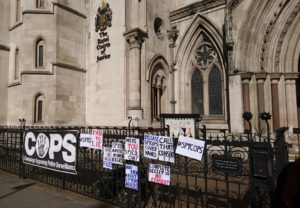 The eighth day of the 2022 Undercover Policing Inquiry‘s hearings examining spycops managers 1968-82 was devoted to the evidence of just one man: Geoffrey Craft (officer HN34).
The eighth day of the 2022 Undercover Policing Inquiry‘s hearings examining spycops managers 1968-82 was devoted to the evidence of just one man: Geoffrey Craft (officer HN34).
Craft was a Detective Inspector with the Special Demonstration Squad (SDS) from May 1974 to October 1976, when he was promoted to head the unit as Detective Chief Inspector, which he remained until October 1977. In 1982 he returned to oversee the spycop unit as Chief Superintendent of ‘S’ Squad.
The pattern of questions remained the same as previous days, starting with his training and understanding of the law. Craft was a much more capable witness than Derek Brice, who gave evidence on the previous day. He was able to responded quickly to questions, many of which clearly irritated him.
On some points he was quite open, but like other officers he suffered inexplicable amnesia about highly significant moments and could not recall the characters of any of the undercovers deployed during his time.
He came across as very much loyal to Special Branch and found little fault with it, and clearly believed that he himself had done nothing wrong, although he did express disappointment in learning about the behaviour of undercovers under his watch. He claims no contemporary knowledge of any of that wrongdoing and appears to characterise himself as naive.
TRAINING AND THE LAW
There was no training or thought given to the lawfulness or ethics of what the SDS was doing, or the intrusion into private life that came from it.
When he joined the SDS, there was no real handover, Craft moved in as second in command to Derek Kneale (officer HN819) who told him what he needed to know. Intelligence was gathered to support public order policing and secondary to that was reporting on subversive activities, material which C Squad – the department concerned with left-wing activists – then channelled to the Security Service (aka MI5). The undercovers’ targets were chosen following discussions on which groups were involved in public order issues at the time.
In an incredible piece of double think, when asked if he had considered back then whether the public would approve of what the SDS was doing, Craft said he had concluded that the public as a whole are happy to live in a parliamentary democracy and public demonstrations were part of that, so the police naturally needed intelligence to ensure appropriate policing.
SUBVERSION
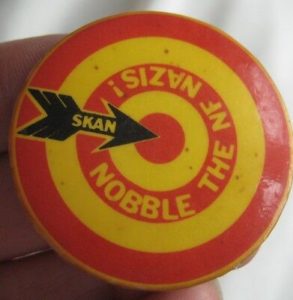
School Kids Against the Nazis badge – this children’s anti-fascist group was a target of spycops
As with previous witnesses, considerable time was devoted to Craft’s understanding of the term subversion. It was clear that he had just gone along with existing practice, and like so many other things had given it little or no consideration.
Basically, he and other Special Branch officers would have absorbed what they needed to know as junior officers and he was comfortable in his own mind what was subversive or not.
This also brought up the issue of spying on school children, covered in previous hearings. Craft’s position was that they would have only been interested in school children if they were involved in one of the organisations they were monitoring for public order purposes.
They would have reported on School Kids Against Nazis because they were supported by the Socialist Workers Party, he said.
This contrasts with the evidence specifically highlighted by lawyers representing ex-undercover officers that this was done at the specific request of MI5 who were interested in ‘subversion’ in schools.
TARGETING
Who an undercover officer should target was a matter for the Chief Superintendent responsible for the SDS, who had to bear in mind it was primarily for public order purposes. However, there would be coordination with the Secret Service (via C Squad) and other squads to avoid duplication, and their views were taken into ‘consideration’ – especially as it was C Squad that had to produce the threat assessments. The SDS was simply a support service in that, albeit a major one.
Craft never considered whether there were alternative ways to get intelligence as that was not ‘S’ Squad’s responsibility – that was down to ‘C’ Squad. Like other managers, he speaks of a cordial relationship with the Security Service, in which the SDS tried to accommodate requests for further information.
Craft was later questioned about the decisions to target a number of specific organisations (see below). What stood out most in his responses was the suggestion that groups were targeted “just in case” and that this was standard practice for the SDS:
“We tried to be ahead of the game, certainly”
USE OF REPORTING
Intelligence gathered by the SDS was passed on to C Squad, who sent it to A8 (Public Order Branch) or the Security Service. In his recollection, a great deal of the intelligence that eventually went to A8 in the form of a C Squad threat assessment was likely to have originated in the SDS. It was unusual for the SDS to have more direct contact, except perhaps at weekends when an undercover may phone in an urgent bit of intelligence during a protest.
A8 and C squad had other sources, but the SDS brought to the public order picture the intentions of the revolutionary groups – especially as those groups tended not to cooperate with the police. Craft repeated the line that it was equally important to reassure A8 that there was not going to be any trouble, to keep policing to a minimum. Otherwise, uniformed police would be pulled off other duties to the detriment of the people of London.
Craft like other mangers said filtering of what intelligence the undercovers provided was not his problem – others decided that. Barr pointedly noted that C Squad, where most of the intelligence went first, did not seem to do a great deal of filtering either. “You’re probably right”, Craft conceded.
Asked why Special Branch wanted reports on individuals, Craft replied it it was for the Security Service. Pushed, he accepted that the intimate personal details recorded were for the Security Service and were not simply a result of lax attitudes. It was not, according to him, used for Special Branch vetting as they only dealt with vetting relating to Irish Republicanism.
FEAR OF THE MEDIA
Craft told the Inquiry that the operational security of the SDS was paramount. This meant that, should the operation become public, the Commissioner needed to have a strong defence: “that the police were acting as the police were sworn to act, in the preservation of the Queen’s peace.”
Asked what he feared, Craft was very clear: the media. More specifically “the attack upon the police by the media, for acting undercover to achieve the result we did.” How he could square that with taking instructions from the Security Service on infiltrating groups that were acting perfectly lawfully but considered ‘subversive’, was a question he failed to answer.
SPILLING THE BEANS
As part of the questioning on the relationship with the Security Service, Barr drew the Inquiry’s attention to document [UCPI0000027451] which discussed the knowledge of the SDS as an undercover unit among other police forces in 1976.
It turns out it was quite well known after a Special Branch course run by the Metropolitan Police Special Branch had included a lecture on the SDS and its successes, given by the unit’s founder Conrad Dixon.
This was later considered have been a mistake and the subject was not supposed to be mentioned again. Craft expressed surprise, saying this was all new to him and he should have known about it.
COVER IDENTITIES
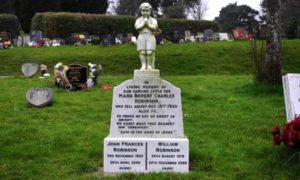
The grave of Mark Robert Robinson whose identity was stolen by spycop Bob Lambert
The practice of stealing dead children’s identities to create cover stories was already in place when Craft arrived on the scene and he did not consider the ethics of it at the time, he just assumed it was legal.
He claimed that because the SDS was a top secret operation it seemed inconceivable that any family would find out.
In hindsight, of course, that isn’t the case, and he says his view now is that bereaved families had suffered enough:
“anything the SDS did to exacerbate that was very sad.”
Barr, for the Inquiry, reminded him that Richard Clark had been exposed by discovery of the death certificate for his stolen identity. Craft elaborated on how difficult it must have been for the activists to find this. However, he did not revisit the utility of the tactic in light of these events.
SUPERVISION & SEXUAL RELATIONSHIPS
The Inquiry came next to the issue of supervision of the undercovers, and – importantly – the managers’ awareness of the sexual relationships. Craft denied knowing anything about the sexual relationships officers had indulged in on his watch.
He was asked about various officers who served under him, many of whom are now known to have engaged in intimate relationships while undercover. Rick Clark (‘Rick Gibson’, officer HN297, 1974-76) and ‘Jim Pickford‘ (officer HN300, 1974-77) came up multiple times during the day, mainly because they were singled out in previous evidence as womanisers who had sexual relationships with women in their target groups.
Craft denied knowing anything of their reputation, and said he did not know any reason why they should not have been undercovers.
Other officers mentioned included:
- ‘Alan Bond‘ (officer HN67, 1981-86)
- Mike Chitty (‘Mike Blake’, officer HN11, 1981-86)
- ‘Barry Tompkins‘ (officer HN106, 1979-83)
- ‘Paul Gray‘ (officer HN126, 1977-82)
- ‘Phil Cooper‘ (officer HN155, 1979-84)
Craft claimed not to be aware of their relationships, nor to have had any concerns about their behaviour. Indeed it made him wonder how well he actually got to know the members of his team.
We heard about the great meetings held twice a week, where allegedly everything was discussed, the camaraderie, how they called each other by their first names, and rank was not an issue.
As he saw it, these get-togethers should have served for the spycops to realise they were still in a police operation, although why he felt that a friendly get together where everyone used first names and rank was not an issue would remind officers it was a police operation was not clear.
Pressed on why he never gave any guidance that sexual relationships were off limits given that the undercovers were young men being put into potentially tricky situations (not least Clark being put into Goldsmiths College), he answered:
“The thought just never crossed my mind.”
However, earlier in his evidence he stated that it was drummed into all police officers that sex while on duty was cause for dismissal and he was even able to cite a case going back to 1830 in support of this.
FILTH
Barr asked Craft to elaborate on a point from his statement where he expressed why he was so against undercover officers having sexual relationships. In his answer Craft started with the risk of disease, and then went on to talk about the wife, the family and marriage. Finally, he referred to things they might have let slip while having sex “which could have damaged the operation”.
Pressed on this, he said that the threat to the family he was thinking of was the risk of sexually transmittable disease and the break-up of the marriage.
The matter-of-fact-way that Craft said this brought home the extent to which female campaigners were viewed as filth, merely potential spreaders of sexually transmissible diseases, rather than human beings with their own rights and dignity. It’s the Met’s contempt for political dissent compounded by their institutional sexism.
Asked about consideration for the woman deceived, Craft said he is not happy about the relationships, musing:
“But what is the alternative? Because accepting that rape is not involved, does all sexual activity in terms of modern moral attitude require a legally endorsed exchange of CVs before sexual activity takes place?
“And so, to the extent to which the man concerned is operating under false colours, is that something which one could prevent? I don’t know.”
Specifically, Craft was not happy with Rick Clark (‘Rick Gibson’, officer HN297, 1974-76) and said as much. Clark never said anything to Craft about the multiple sexual encounters he had had while undercover, which – according to what he told contemporaries – had contributed to his exposure.
Craft also did not like the fact he had not picked up on that at the time – clearly seeing it as a his own failure, though only in hindsight. At the very end of the day, in further questioning, he was asked how come he didn’t have the same opinion of Rick Clark, and another officer, ‘Jim Pickford‘ (officer HN300, 1974-77) that other witnesses have shared with the Inquiry?
His response may have actually contained some truth:
“People that are good at putting up a front can sometimes confuse one.”
In this, he is effectively claiming that both men had concealed their misconduct from their bosses, and blaming his own naïvety.
He claims no memory of Vince Harvey (‘Vince Miller’, officer HN354, 1976-79) coming to him for advice about the “amorous” attentions of an Socialist Workers Party member.
BOB LAMBERT
Even more unlikely, he stated that he never came across Bob Lambert (‘Bob Robinson’, officer HN10, 1983-88).
One of Lambert’s colleagues, whistleblower Peter Francis, has spoken of the unparalleled regard Lambert was held in long after his undercover deployment:
“He did what is hands down regarded as the best tour of duty ever”
Lambert was involved in the most shocking activities of the spycops. He stole the identity of a dead child, was prosecuted under his false identity, acted as an agent provocateur (allegedly burning down a shop) and deceived women he spied on into sexual relationships, including having a child with one.
Lambert later went on to run the SDS in the 1990s, deploying other officers to act similarly.
‘Who is Bob Lambert?’ – talk given by COPS, March 2015
Bob Lambert is one of the pre-eminent figures in SDS history, and his exposure in October 2011 was one of the pivotal moments in the spycops scandal.
Craft said:
“I wouldn’t recognise the man.”
He also says he was shocked to discover that Lambert had fathered a child with an activist:
“One wonders how he had the time.”
Asked what he would have done had he learned about an undercover having sex, Craft confidently declared he would have removed the undercover from the field.
At this point the Inquiry’s Chair, Sir John Mitting, intervened, asking whether the undercover would have been formally disciplined. Craft answered in theory yes, but there would have had to be a hearing, which would potentially expose the secret unit, so probably not.
WIVES & WELFARE
The thinking behind using married officers, according to Craft, is that the home life gave them something stable to return to, away from the stress of undercover life. It was all about stability, not about preventing sexual relationships.
Craft was asked about the officers’ wives. He said he didn’t always visit the wives of new recruits; they were invited to Christmas parties. He admitted that – despite the importance of these officers being married and enjoying stable home lives – there was no ongoing monitoring of their marriages, and not much care and attention paid to their wives. In retrospect, he sees that the job would have had an impact on them, and says the police should have done more to look after them.
He explained the reason for deployments tending to last four years, and said that the concerns he had about lengthy deployments were about the officers’ well-being but not because he considered any risk to family life, or an increased risk of what he termed “transgressions”.
POSITIONS OF RESPONSIBILITY
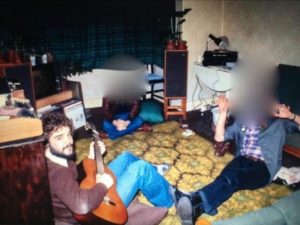
Special Demonstration Squad officer Vince Harvey aka ‘Vince Miller’ while undercover
Craft claimed that undercovers he was supervising did not rise high in the ranks of the groups they were targeting. However, it quickly became clear that they did.
Richard Clark rose through the ranks of the Troops Out Movement (TOM) to become National Convener. Craft said he would not have approved of this.
Clark got involved in factional in-fighting – why wasn’t that stopped? Craft doesn’t know, and he can’t explain why he did nothing.
However he does seem to have approved of Vince Harvey (‘Vince Miller’, officer HN354, 1976-79) becoming both Treasurer and Secretary of Socialist Workers Party branches – agreeing that this represented a “fantastic opportunity” as “it clearly gave him access to all the membership”.
‘Phil Cooper‘ (officer HN155, 1979-84) and ‘Colin Clark’ (officer HN80, 1977-82) – also held “significant positions” within the Party and had access to the Party’s headquarters.
Would Craft have considered it proper or improper for someone to take or copy documents?
“Proper” was his prompt response – it was a “jolly good thing” – he would have completely approved and seen their work as very valuable; he still doesn’t consider that anything these officers did was illegal.
‘Gary Roberts‘ (officer HN353, 1974-78), in his witness statement, tells how he got involved in the student union at Thames Polytechnic, becoming Vice President, and attended National Union of Students conferences as an official delegate. Why didn’t Craft tell him not to take up this position?
Craft’s only respoded:
“It had happened so we were stuck with it.”
POLICE ARRESTED
We heard about a number of officers who were arrested during Craft’s tenure.
‘Desmond “Barry” Loader’ (officer HN13, 1975-78), was arrested and prosecuted on two occasions.
Loader’s first arrest (described on page 12 of this ‘Minute sheet’) took place on an anti-fascist march from Ilford to Barking in September 1977, which he attended with his ‘comrades’ from the Communist Party of England (Marxist-Leninist). He was arrested under the Public Order Act, allegedly while “shielding two children” from the police, and is said is have been “somewhat battered”.
The case was complicated by an arresting officer having served with this undercover years earlier. This led to concerns about him being recognised in court, blowing his cover.
Craft went along to Barking Magistrates for a conversation with this Constable and met with a magistrate and a “helpful” clerk. Later entries show the SDS remained in contact with these officials. The trial eventually took place in 1978 – by this time Craft had moved on, and his successor, Ken Pryde, was in post.
We also heard about ‘Michael Hartley‘ (officer HN12, 1982-85) being arrested for fly posting on Holloway Road, alongside a ‘comrade’ from the Revolutionary Communist Group (RCG).
Craft denied remembering this case, or considering the fairness of the other RCG member being prosecuted. This report was signed off by Craft and sent to the Commander of Operations.
UNDER CONSTANT REVIEW?
In a covering letter attached to the 1976 annual report we see the claim that the SDS was engaged in “constant review”, with reference to a small working party examining the unit’s work in detail, and increasing its effectiveness as well as shrinking the number of personnel required (to 12 deployments, which is said to be the minimum required to gather the necessary level of intelligence).
This working party was the only formal review of the SDS that Craft can recall. Barr pointed out that it was therefore a bit of an exaggeration to call it constant review. “I think it’s painting a slightly strong picture” admitted Craft
After seeing some letters of thanks and appreciation – such as one from Lancashire police following a demo in September 1976 and another one from 1977 – we heard more about the results of the Watts working party in 1976. The review found that, though public disorder at protests had declined since the SDS’s formation, police and the Security Service thought the SDS should continue its work.
WHAT WAS THE POINT?
Why couldn’t the police just monitor open sources and talk to activists? Craft claimed that undercover tactics were essential because the people they were spying on would never have told the police what they were up to.
“Accurate, timely intelligence was vital for proportionate policing and for keeping the peace”.
He insists that the SDS made a considerable difference to the policing of public order. The benefits for the Security Service are described as ‘off-spin’.
Craft was promoted in mid 1981, to run S Squad, and so had oversight of the SDS for the next three years – he calls it a “fairly close” relationship and says he sometimes visited the office and had discussions with those in the field.
What did they talk about? Just general stuff.
Does he recall any problems or welfare issues arising? What about new officers? Were you involved in discussing deployments? Probably not – Craft claims this would probably have been a conversation between the SDS and C Squad
RED LION SQUARE
Barr read an excerpt from the unit’s 1974 Annual Report (paragraph 20 on page 13) – about the death of Kevin Gately on 15 June during mounted police charges into a crowd at an anti-fascist demo at Red Lion Square, London.
Craft may have written this paragraph, but he isn’t sure. It mentions the SDS giving the uniformed police:
“forewarning of both the size of the demonstration and the possible disorder which might occur.”
However, while Craft knows that the SDS had undercovers deployed in most of the left-wing groups involved, he can’t remember any specifics about what intelligence the unit was able to contribute, nor how they did so. The Inquiry has failed to find any other evidence relating to this.
WHO TO SPY ON?
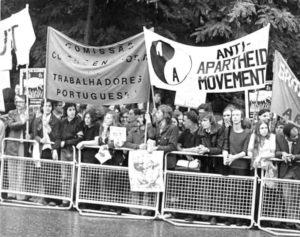
Anti-Apartheid Movement demonstration, London, 15 July 1973
A number of Barr’s questions examined the motives behind the targeting of specific groups or events.
In reference to the far-right, Craft spoke about how “essential” it was to collect intelligence about extreme groups at both ends of the spectrum if the police were to successfully keep the peace between them. He confirmed that he did offer the SDS’ services for this purpose, but ultimately it was C Squad who decided.
When it came to the anti-racist groups, he said those who cooperated with the police were of no concern; those who didn’t were seen as a problem.
Asked why the Anti-Apartheid Movement was reported on (before his time in the unit) he said they were involved in disorder and criminal damage, referencing the direct action taken by the Stop the Seventy Tour campaign.
He admitted that the group had been “very thoroughly infiltrated” as a result of a reputational “hangover”, even though it was run by Young Liberals, rather than ‘ultra Left’ types.
Barr also asked about the Troops Out Movement (referenced in the SDS’s 1976 Annual Report). Craft admitted that TOM wasn’t seeking to overthrow the State and wasn’t really a public order threat. He attempted to justify their infiltration – describing them as “an umbrella movement” who might be infiltrated or ‘manipulated’ by the ‘ultra Left’, or attract Irish Republican support – it was here that he expressed the opinion that it was best to infiltrate them “just in case”.
In relation to the various anarchist and situationist groups, Barr pointed out that that Roy Creamer (officer HN3903, who gave evidence earlier in the week) had painted a benign picture of – for example – the Freedom Press.
Craft said he was “happy to bow to Roy Creamer’s expert knowledge” rather than attempt to distinguish between the various groups – it was “quite beyond me”.
In 1976 Richard Clark’s cover was compromised. The group he was infiltrating, Big Flame, is listed on page 4 of the Annual Report, described as a “sinister” organisation, albeit one with no known illegality. It is reported that members are “well-educated” and have links to the Angry Brigade. It is also credited with “practical ingenuity” in the field of security consciousness, compared to other ultra-Left groups:
“There is little doubt that this organisation has more to hide, and hence more to fear, from the police than some of the others”.
Craft says he’s “hesitant” to talk more about this paragraph now. This was possibly a reference to his slip-up, saying something that should have been restricted, earlier in the day.
DUBIOUS DEPLOYMENT DECISIONS
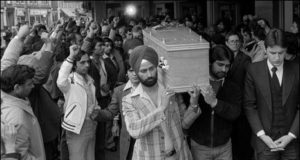
Blair Peach’s funeral, June 1979. Spycops were among the mourners, reporting names of others who attended
Was it Craft who instructed one of the undercovers to attend the funeral of Blair Peach, who was killed by police on an anti-fascist demonstration in 1979?
He doubts it, but can’t be sure. He agrees that Peach’s death and inquest were “bad news for the Met police” (the inquest found that Peach had been killed by a police officer). Did the SDS take a special interest in the campaign? Only in that it would have been wise to keep an eye on them in case of disorder, Craft asserts.
Why was the Campaign for Nucelar Disarmament (CND) targeted? Obviously a male officer couldn’t have infiltrated the women’s peace camp at Greenham Common – in Craft’s words, they needed “a lady” for this.
Craft claims this is the only time that the SDS had any interest in CND, however the Inquiry already knows that John Kerry (officer HN65, 1980-84) infiltrated CND itself.
What about animal rights – why were you interested in spying on them? Craft talked about firebombs, attacks on research centres, “quite akin to terrorism”. He went on to say that he thought this whole thing “started with one policeman in Essex who was keeping an index” and the Branch took this over, realising the movement was “dangerous”.
The SDS’s 1974 Annual Report describes the Workers Revolutionary Party (WRP) as a “highly disciplined organisation” that has not caused any public order problems (paragraph 28, page 15). Their interest in “industrial unrest” is mentioned, and Craft openly admitted that this would have been purely for the benefit of the Security Service.
Several spycops infiltrated the WRP but these deployments ended in Craft’s time – does he recall why? He doesn’t, but imagines they were no longer considered a threat to public order. (Former WRP member Liz Leicester gave evidence to the Inquiry last week.)
The Inquiry noted that Craft signed off on every Annual Report during this era, and always endorsed them in glowing terms, in the knowledge that these went to the Home Office and were instrumental in securing the go-ahead (and funding) for the spycops operations to continue.
PRAISE FROM THE HIGHEST LEVEL
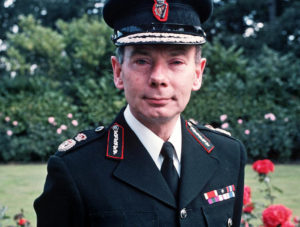
Sir Kenneth Newman, Met Commissioner 1982-87, congratulated the spycops
Craft still believes in the immense value of the SDS’s work. He remembers the Commissioner visiting the SDS while he was running the unit – he visited the safe house, met the undercovers, ate lunch with them – “he was chatting to everybody”. Craft remembers “it was good for morale”.
He was similarly positive about another visit paid to the SDS safe house by the Home Secretary, accompanied by the Met Commissioner, Sir Kenneth Newman, while he was at S Squad.
This means the Inquiry has now heard that every Commissioner from the squad’s inception in 1968 until 1993 was personally involved and approved.
- 1968-72 – John Waldron
Rajiv Menon QC told the Inquiry Waldron gave officers champagne after an October 1968 Vietnam War protest - 1972-77 – Robert Mark
Spycop Graham Coates told the Inquiry Mark visited the safe house to congratulate officer - 1977-82 David McNee
Spycop Roger Harris told the Inquiry Mark and McNee both visited the safe house - 1982-87 – Kenneth Newman
Geoff Craft told the Inquiry Newman visited with the Home Secretary - 1987-93 – Peter Imbert
Imbert was previously a Special Branch officer, spycop ‘Sandra Davis’ told the Inquiry Imbert personally recruited her to the SDS
Additionally, before the Inquiry began, whistleblower officer Peter Francis described how the Commissioner he served under (Paul Condon, 1993-2000) visited the safe house and gave out bottles of whisky as a token of his gratutude.
This completely demolishes the Met’s earlier claims that the SDS was some kind of ‘rogue unit’ that senior officers were unaware of.
However, the Inquiry will not be hearing evidence from Sir Kenneth Newman, nor David McNee or Peter Imbert. All three of them have died since the Inquiry began.
It’s not enough to know what the spycops did. We need to know who authorised and sanctioned these operations. We need to know why. The loss of testimony from those Commissioners, who were ultimately in charge of the SDS for a third of its existence, is one of the effects of the colossal delays the police have inflicted on the Inquiry process.
FINAL QUESTIONS
Craft was questioned more about ‘Phil Cooper‘ (officer HN155, 1979-84). According to a Security Service note from a meeting with Detective Inspector ‘Sean Lynch‘ (officer HN68, 1968-74) in the summer of 1982:
“despite his misdemeanours, Cooper has not been withdrawn as an SDS source”.
‘Lynch’ is said to be worried:
“because Cooper’s position in the Right To Work movement gives him regular access to Ernie Roberts MP and meetings at the House of Commons”.
We know that ‘Cooper’ was having marital difficulties at this time; it sounds as though anything about his work becoming public could have had serious consequences, and been highly embarrassing for all concerned. Craft agrees that he too would have been concerned – this was “too close” to what he calls “legitimate politics”.
Craft was asked if he had ever heard the term “Wearies” – used to refer to the activists spied on by the SDS – and he denied ever hearing it, then or since, adding “I don’t even know what it means”.
There was one final lasting confusion. Craft does not recall Angus McIntosh (officer HN244) working in the SDS office as his deputy. But as far as the Inquiry knows, their time in the unit definitely overlapped. We’re due to hear McIntosh’s evidence tomorrow, on Day 9, so perhaps this mystery will be cleared up then. Craft has repeatedly said he’s “confused” by this:
“It’s amazing – I know him very well – but have no recollection at all of working with him in the SDS”
Craft has submitted two written witness statements to the Inquiry:
First witness statement (December 2020)
Second witness statement (February 2022)
Documents referred to are listed in the Inquiry’s Bundle for the day.
Video of the morning and afternoon the day’s hearing
The current round of Undercover Policing Inquiry hearings, focusing on Special Demonstration Squad managers 1968-82, continue until Friday 20 May.

One comment on “UCPI Daily Report, 18 May 2022”